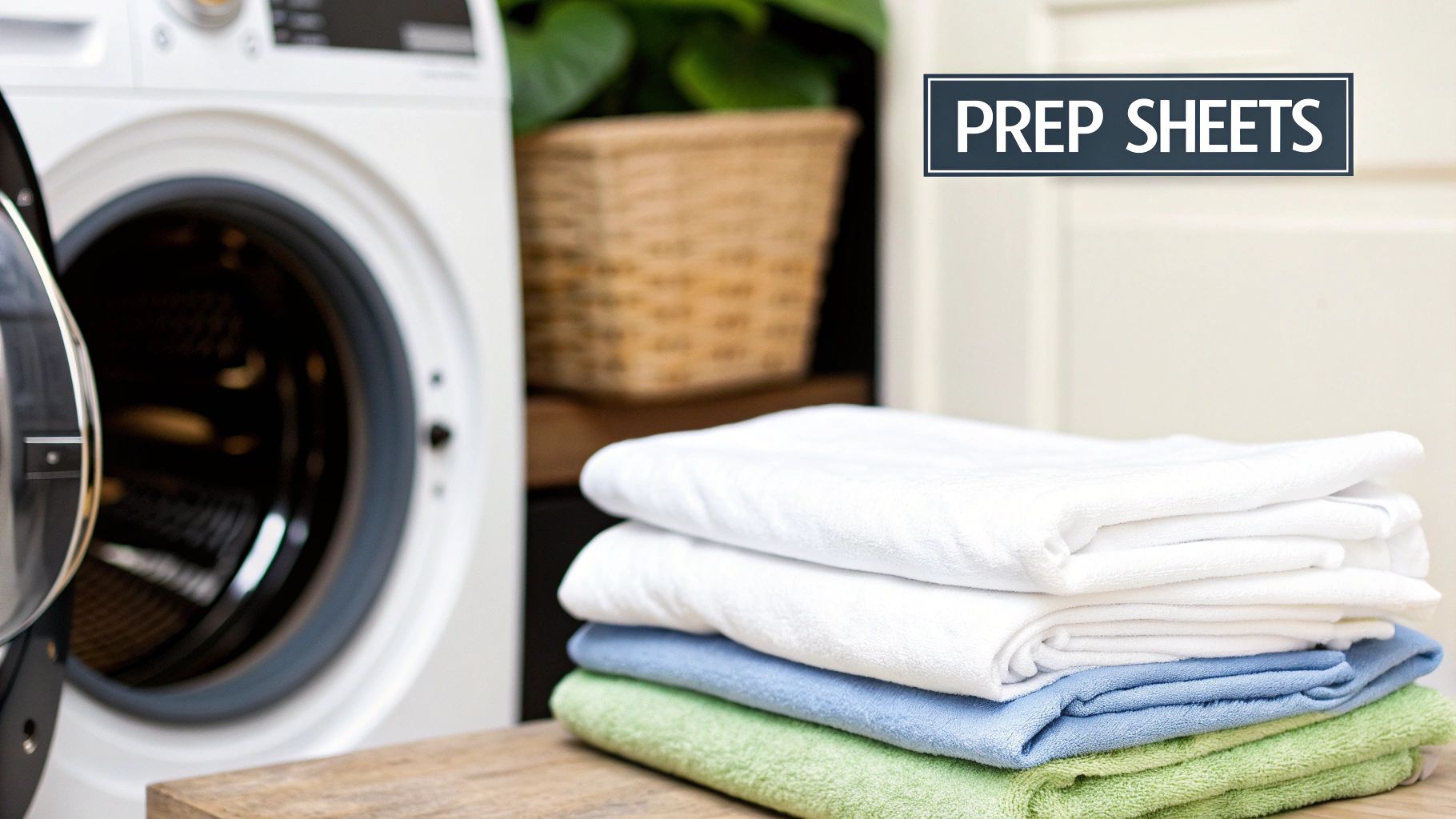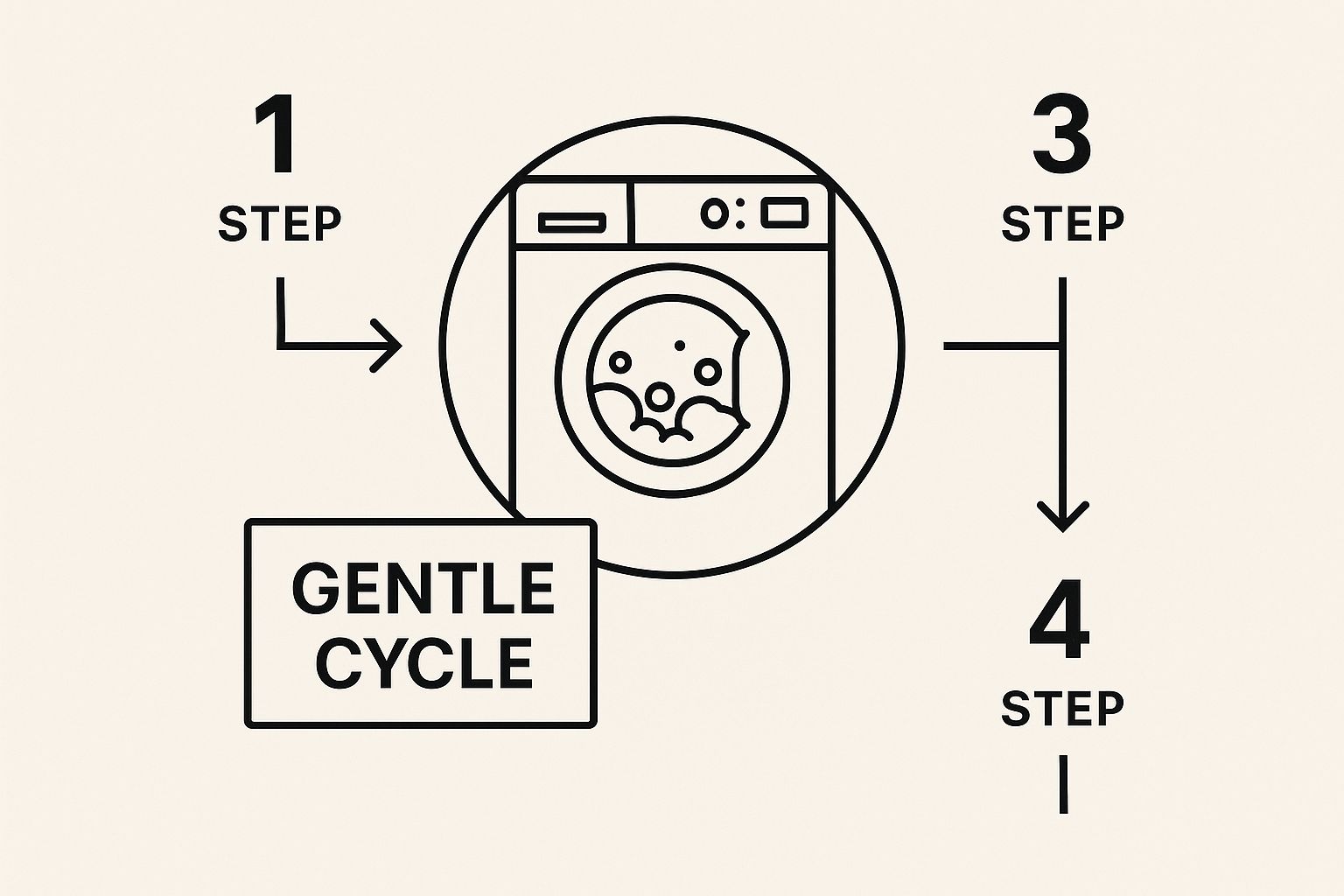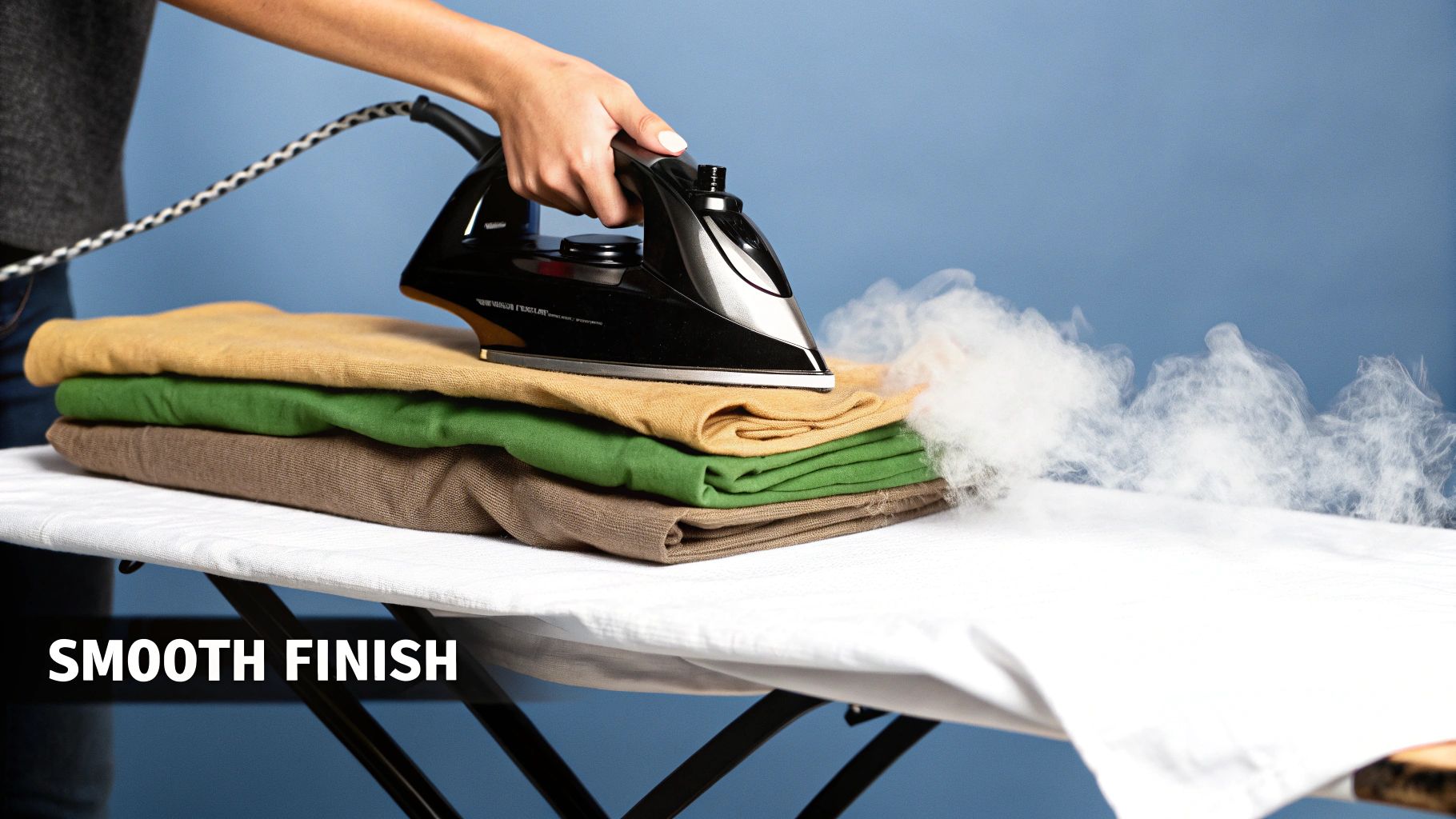When it comes to washing your beautiful linen sheets, it's time to forget the old "boil wash" mentality. The real trick to getting that signature softness is a gentle touch. Think lukewarm water, a gentle cycle, and a mild detergent. You'll want to steer clear of fabric softeners and bleach entirely—they actually harm the natural fibres and stop your linen from getting softer with each wash.
How To Wash Linen Sheets for Lasting Softness
Caring for linen is all about working with the fabric, not against it. Harsh chemicals and aggressive cycles are out. A gentler approach is in, and it’s what helps your sheets get softer and cosier every time you wash them. I've found that the right technique turns a simple set of sheets into a genuine sleep haven.
This is your go-to guide for keeping the strength, breathability, and pure comfort of your favourite bedding intact for years to come.

The Basics of Linen Laundry
The main principle behind washing linen is simple: be kind to it. Linen's long, natural fibres are incredibly strong, but they respond best to gentle handling. This just means paying attention to a few simple things in your laundry routine.
From my own experience, I can tell you that a little bit of care makes a huge difference, transforming good linen into something truly special.
Here’s what you need to focus on:
- Water Temperature: Hot water is a no-go. It can make linen shrink and weakens the fibres over time. Lukewarm is the sweet spot for getting things clean without causing damage.
- Washing Machine Settings: Always choose a gentle cycle with a low spin. This is non-negotiable. It stops the fibres from getting stretched or stressed during the wash.
- Choosing a Detergent: Harsh chemicals are linen’s biggest enemy. A mild, pH-neutral liquid detergent is your best friend here, as it cleans without stripping the fabric.
Local Tips for Linen Care in New Zealand
Down here in New Zealand, we know a thing or two about looking after natural materials. The consensus from local experts is to wash linen bedding in either cold or lukewarm water, ideally no hotter than 40°C (104°F). This temperature cleans perfectly while protecting those precious fibres.
It’s also crucial to stick with mild liquid detergents and completely avoid bleach and fabric softeners, as they break down the material.
Key Takeaway: The secret to long-lasting linen isn't complicated. It’s all about respecting the fabric's natural state by avoiding aggressive washing and harsh chemicals.
To help you get it right every time, here's a quick summary of the ideal settings for your machine.
Quick Guide to Washing Linen Sheets
| Setting / Item | Recommendation | Reason |
|---|---|---|
| Water Temperature | Lukewarm (up to 40°C) | Cleans effectively without causing shrinkage or fibre damage. |
| Machine Cycle | Gentle or Delicates | Prevents stretching and undue stress on the long linen fibres. |
| Spin Speed | Low | Reduces creasing and protects the fabric's integrity. |
| Detergent | Mild, pH-neutral liquid | Cleans gently without harsh chemicals that can degrade the linen. |
| Avoid | Fabric Softeners & Bleach | These coat or damage fibres, preventing them from softening naturally. |
Following this simple guide will ensure your linen not only lasts but gets better and better with every single wash.
For even more advice on taking your laundry game to the next level, you might want to check out these expert tips for elevating your bed linen washing routine.
The Secret to a Perfect Wash Starts Before You Press Start
Getting your linen sheets perfectly clean isn't just about what happens inside the washing machine. A few simple prep steps are the key to keeping them looking and feeling incredible for years to come. Think of it as laying the groundwork for a flawless wash, preventing common issues like colour transfer and unnecessary wear on the fibres.
First things first: sort your laundry. I know, it sounds basic, but this is a golden rule for a reason. Always separate your whites, lights, and darks. This is your best defence against your beautiful coloured linens accidentally dyeing your crisp whites a murky shade. It's especially crucial for the first few washes of a new set when dyes are most likely to run.
Give Your Linens Room to Breathe
One of the biggest mistakes I see people make is cramming their washing machine to the brim. Your linen sheets need space to move! When they’re packed in too tightly, the water and detergent simply can't get everywhere they need to go, meaning you get a patchy, subpar clean.
A loosely packed drum is the secret weapon against excessive wrinkling. When your sheets have plenty of room to tumble freely, they come out much smoother and less creased. It makes a huge difference.
Tackling Stains Head-On
Life happens. Whether it's a splash of morning coffee or a drop from a late-night snack, stains are inevitable. The trick is to deal with them before they go into the main wash. You don’t need to reach for harsh chemical removers; a gentle touch is all it takes to protect those lovely linen fibres.
For most common spills, a simple paste of baking soda and water works wonders. Just apply it to the spot, let it sit for about 15-20 minutes, and then pop it in the wash. A dab of white vinegar can also be effective. For those more stubborn marks, it’s worth looking into some other gentle, natural cleaning solutions for your home that are safe for your fabrics. Taking a moment to pre-treat ensures your investment stays looking pristine.
Picking the Right Wash Settings and Soap
Standing in front of a modern washing machine can feel like you're in a cockpit, with all its knobs and glowing lights. But when it comes to washing your linen sheets, the best approach is actually the simplest one. The goal is always to be gentle. You want to protect those long, lovely linen fibres from the rough and tumble that leads to pilling and wear over the years.
What does that look like in practice? It means choosing a delicate cycle paired with a low spin setting. It might be tempting to use a high-speed spin to get more water out, but that force puts a huge amount of stress on linen. It can cause deep-set wrinkles before your sheets even see the dryer and just wears them out faster. A gentle cycle with a slow spin will get them perfectly clean while keeping the fabric happy.

The Best Temperature and Detergent for Linen
Getting the water temperature right is just as important. For linen, the magic number is around 40°C, or what you’d call lukewarm. This is the perfect middle ground—warm enough to properly dissolve the detergent and wash away dirt and oils, but cool enough that you don't risk shrinking or damaging the fibres.
Your choice of detergent makes a real difference, too. I always recommend a mild, pH-neutral liquid detergent. Some harsh powders contain gritty fillers that don’t always dissolve fully, leaving behind a residue that can break down the fabric over time. A good quality liquid soap is a much safer bet.
A Quick Word of Warning: Steer clear of fabric softeners and chlorine bleach. Fabric softeners leave a waxy coating on the fibres, which completely ruins linen's amazing natural absorbency and breathability. Bleach is simply too harsh; it will weaken and can even yellow the fabric for good.
If you follow these simple guidelines, you'll find your linen gets softer and more beautiful all on its own with every wash. For a deeper dive into what makes a good soap, check out our guide on what to look for in laundry products. Taking a gentle approach from the start is the secret to enjoying your sheets for many years to come.
Right, so you've washed your linen sheets perfectly. Now comes the final, make-or-break step: drying them for that signature, lived-in softness. How you handle this part of the process truly defines the end result.
If you ask me, nothing beats the old-fashioned line-drying method. Honestly, I can't recommend it enough. Letting your linen dance in a gentle breeze does something magical to the flax fibres, softening them in a way a machine just can't imitate. It's the absolute gold standard for a reason.
But let's be realistic, line-drying isn't always an option. If you're turning to the tumble dryer, you need to be careful. Always, and I mean always, choose a low-heat or delicate setting. Blasting linen with high heat is a fast track to making the fibres brittle and stiff over time.
The Real Secret to Fewer Wrinkles
Here’s the most important tip I can give you: pull your sheets out of the dryer while they’re still slightly damp. This is key. Over-drying is the number one cause of deep-set wrinkles and that scratchy feeling nobody wants.
Let them finish air-drying by draping them over a drying rack, a clean chair, or even putting them straight back on your bed to finish.
For an extra touch of softness, toss a few wool dryer balls in with your sheets. They're a brilliant, chemical-free alternative to dryer sheets. They help fluff up the fabric, cut down on static, and can even reduce the overall drying time.
This mindful approach to laundry is becoming more common, especially as people invest in higher-quality bedding. It's no surprise that the New Zealand bedding market is projected to hit around NZD 128.82 million by 2025. This trend shows a real shift towards Kiwis wanting premium, sustainable options like linen and learning the right way to care for them. If you're interested in the data, there's a great Euromonitor report on laundry care trends that dives deeper.
By simply avoiding high heat and taking your sheets out a little early, you'll be rewarded with softer, smoother linen that lasts for years. It’s a small change in your routine that makes a world of difference to how your bed feels.
Smart Storage and Everyday Linen Care
Properly caring for your linen sheets goes well beyond laundry day. If you want them to stay beautifully soft and last for years, your daily habits and how you store them are just as important as your washing technique.

One of the most common questions I get is about how often you should actually wash your sheets. Here in New Zealand, I’ve found that washing them every one to two weeks is the sweet spot. Given the average person sweats around 200ml each night, this frequency keeps things hygienic without putting too much stress on the natural fibres. This schedule helps manage the build-up of allergens and bacteria without overdoing it.
Proper Storage and Sheet Rotation
When you're not using your linen, think of it like storing a fine wine—it needs a cool, dry, and dark place. Your linen cupboard is perfect, as is a good storage chest, as long as it's well-ventilated. The biggest enemy here is direct sunlight, which will fade those beautiful colours and can cause yellowing over time.
If there's one tip I could give for making your linen last, it's this: own at least two sets of sheets and rotate them regularly. It’s a simple change that dramatically cuts down on wear and tear, effectively doubling the life of each set.
For longer, seasonal storage, knowing the best ways to store clothes long term can be a game-changer for preserving your linen's softness and integrity.
Finally, give yourself permission to embrace linen’s unique personality. That slightly rumpled, natural texture is what makes it so special. There's really no need to get the iron out; that effortlessly chic, lived-in look is the whole point. Just smooth them out on the bed when they’re dry and enjoy the relaxed feel they bring to your bedroom.
Common Linen Washing Questions Answered
Even with the best instructions, taking care of linen can feel a bit like learning a new skill. I get it. After years of working with this beautiful fabric, I’ve heard just about every question you can imagine.
So, I’ve pulled together the most common ones right here to give you some clear, straightforward answers. Let’s sort these out.
Why Are My Linen Sheets So Wrinkled?
Wrinkles are part of linen's signature relaxed look, but when your sheets come out looking like a crumpled-up map, something’s not quite right. Usually, the culprits are an overzealous spin cycle and a washing machine that’s packed too tightly. Linen needs space to breathe and move around in the wash.
Here’s how to get that perfectly rumpled, not overly-creased, finish:
- Stick to a gentle cycle with a low spin speed. This is much kinder to the flax fibres.
- Don't cram the machine. Ideally, wash one set of sheets at a time to give them plenty of room.
- As soon as the wash is done, pull them out and give each piece a good, firm shake. You'll be surprised at how many wrinkles this simple action removes before you even start drying.
Making these small tweaks really does make a massive difference. You’ll get that effortlessly elegant look everyone loves about linen.
Can I Use Fabric Softener on Linen?
I’m going to be direct with this one: absolutely not. This is probably the most important rule of linen care. Fabric softeners coat the fibres in a waxy film, which is the very last thing you want for your beautiful sheets.
This coating essentially suffocates the flax fibres, clogging their natural pores and ruining their famous breathability and absorbency. With repeated use, your linen will actually feel stiff and the fibres can become brittle and break. Trust me, your linen will get softer and softer all on its own, with every single wash.
How Do I Remove Stains from White Linen?
Speed is your friend here. The moment a spill happens, grab a clean cloth and blot the area gently. Whatever you do, don't rub—that just pushes the stain deeper into the weave.
For spot-treating, you can’t go wrong with a simple paste made from baking soda and water. It's gentle but effective. Just apply it to the stain, let it sit for around 20 minutes, and then pop the sheets in the wash as usual.
Never, ever use chlorine bleach on linen. It will permanently yellow the fabric and severely weaken the fibres.
Pro Tip: For those stubborn spots on white linen, sunshine is your secret weapon. After washing, hang the damp sheets out on the line. The sun’s natural UV rays are a brilliant, chemical-free bleach that works wonders.
For more helpful advice, you can explore other ideas for creating a beautiful home with linen in our blog.
At The Foxes Den, we believe that caring for your linen should be as luxurious as sleeping in it. Discover our curated collection of premium linen bedding to bring timeless elegance and comfort into your home. Explore our collection today.
Article created using Outrank

